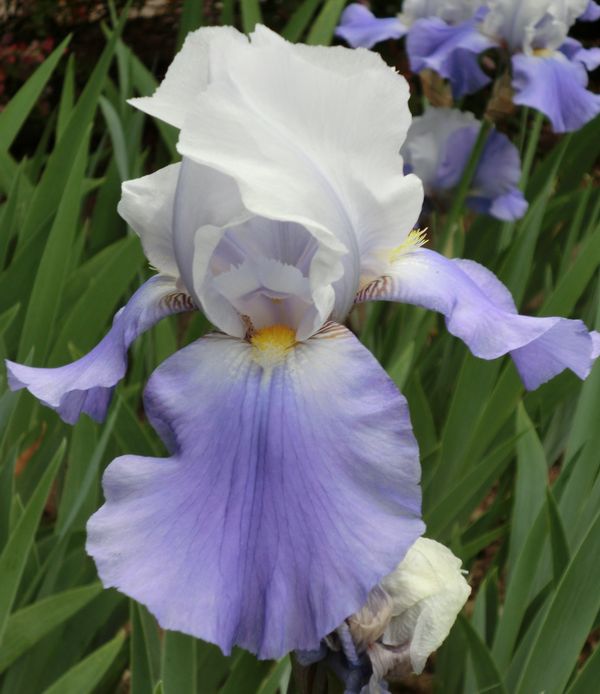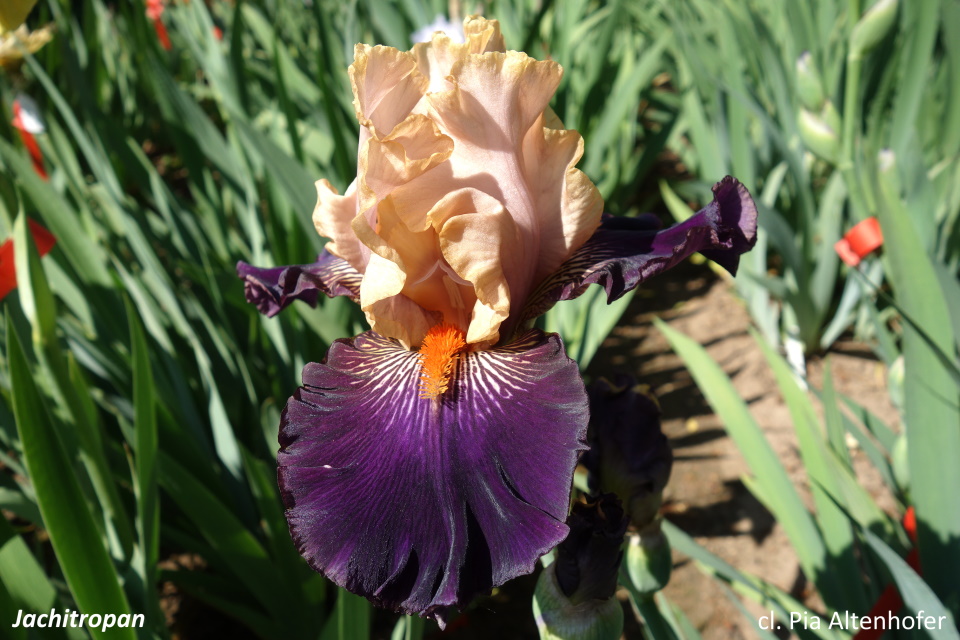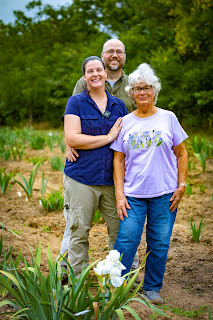by Sylvain Ruaud
The Gesellschaft der Staudenfreunde (GDS, translation: Society for Perennials) website offers a historical perspective on iris development in Germany:
Translation: After World War II,
it was the hybridization successes of Steffen, Werckmeister, Hanselmayer, Dorn,
Steiger and von Martin, which ensured a constant presence of Central European
breeders in the development of iris. (...) the reader's interest should be
drawn to the still living and active iris breeders in the GDS catchment area,
whose work contributes to the worldwide development of new iris varieties. All
of them started as amateur gardeners and then, driven by a passion for plant
creation, became specialists in their fields of hybridization. They often sell the
irises they have grown themselves, but usually only to cover the cost of their
hobby and never to make a living from it. For their audience, they compete with
the almost overwhelming predominance of iris varieties bred by the large
nurseries in the United States. In any case, home-grown varieties have the
advantage of being better adapted to our climatic conditions.
In France, little is known about German iris
production, especially because of the almost complete lack of marketing
explained above. However, it is important -- even more important than the French
production in the years 1980-1990. German breeders, being very serious and
disciplined, have always registered their new varieties. French breeders of the same era were convinced that their work had little value and did not choose to submit registrations. It is time that we get acquainted with these Germanic hybridizers,
long isolated on the east side of the Rhine.
During the period immediately after World War II, breeding activity gradually reawakened. Old American varieties which remained in gardens were the main stock used for hybridization. Activity became more interesting from the 1970s and was accompanied by new prosperity of the German economy (mainly in the West, of
course).
Eva Heimann from Berlin is among the forerunners of the movement, and her advancements took place in the late 1970s and early 1980s. At about the same time
Erhard Wörfel, who was the president of the GDS, hybridized for his own pleasure and obtained some nice
irises, like the white 'Berthalda' (1983).
'Berthalda' (Woerfel, 1983)Lothar Denkewitz was active a little later. This citizen of
Hamburg was mainly interested in standard dwarf irises (SDB) as shown by his
yellow amoena 'Sonnentrude' from 1985, as well as the TB 'Alstersegel' (1981)
very classic lavender blue amoena.


'Sonnentrude' (Denkewitz, 1985) 'Alstersegel' (Denkewitz, 1981)
The period of activity of Eberhard Fischer
is even a little later, since it extends until the end of the 20th century.
This scientist hybridized irises with the same seriousness that he put into his
scientific work. This can be seen in 'Kristallpalast' (1993) - orange pink - or
'Schneewittchen' (1999) - pure white.
"Kristallpalast' (Fischer 1993)
The work of Harald Moos, which focuses
on tall bearded irises, has been more extensive. It has been going on for almost
forty years with a quiet regularity. His work has been noticed in Florence, mainly
with 'Leibniz' (1989) whose perfect shape and light orange color is
appreciated. The white 'Weisse Duene' (2009) was presented at Franciris where
several collectors were envious of it.
'Weisse Duene' (Moos, 2009)
Then there is Manfred Beer. He too is a
specialist in large irises, he too has been working for more than thirty years
and regularly exhibits in all European competitions. There is no field in which
he excels more than in another and his catalog shows a beautiful eclecticism
but remains in a pure classicism. What we notice is that most of his varieties
have female names. Among these ladies are 'Melanie Steuernagel' (2000), 'Renate Leitmeyer' (2001) and the dark 'Lydia Schimpf' (2006).
'Melanie Steuernagel' (Beer, 2000)
'Lydia Schimpf' (Beer, 2006)
Siegmar Görbitz is one of those tireless amateurs who
hybridize mainly for their own pleasure. His first registrations date back to the
1980s. He has made a specialty of blue or purple irises, which show real talent planted outside their native garden. This is the case, for example, with 'Fürstin Pauline' (1997) or 'Detmolder Schlossgarten' (2009).
'Detmolder Schlossgarten' (Gerbitz, 2009)Since the reunification of Germany there has
been a real craze for iris cultivation in the former East Germany. Among these
newcomers Günter Diedrich, Wolfgang Landgraf, Bernhard Lesche,
Margitta Herrn, and Klaus Burkhardt, show great inventiveness and have produced very modern varieties which can compete with what is done elsewhere in
Europe. Examples are the variegata 'Mondsheinserenade' (Diedrich, 2009),
'Plauen' (Landgraf, 2007), a descendant of 'Edith Wolford' (Ben Hager, 1986) or
'Broken Cleopatra' (Burkhardt, 2021), a dark grandchild of 'Tiger Honey' (Brad Kasperek, 1994).
'Mondscheinserenade' (Diedrich, 2009)
'Plauen' (Landgraf, 2007)
'Broken Cleopatra' (Burkhardt. 2021)
Pia Altenhofer is another of the young shoots of German
iridophilia. We have already spoken here about her creations, often original,
which are characterized by their name made up of an assembly of letters,
without any meaning. This young woman does not hesitate to hybridize all kinds
of categories of bearded iris. Her TB 'Jachitropan' (2021) was noticed in
Florence. Her small mustard yellow MTB 'Imprikasa' (2020) is very much in line
with today's fashion. We should hear about her at the highest level in the
years to come.
Jachitropan' (Altenhofer, 2021)
'Imprikasa' (Altenhofer, 2020)
The above breeders have worked mainly with
large garden irises (TBs), but others have been interested in other categories,
mainly SDBs, but also arilbreds, as is the case for Harald Mathes and his superb
'Anacrusis' (1992), dark garnet, which has been a worldwide success.
'Anacrusis' (Mathes, 1992)
Eckhard Berlin was much more eclectic.
His small number of registrations include MDB, SDB, SIB and, as an additional
originality, a series of Iris pseudacorus of which 'Beuron' (1980) cultivated in
France by Jean Claude Jacob is a part. Frank and Christine Kathe,
in Dresden, specialize in standard dwarf irises (SDB) like 'Pastell Ballett'
(2006), cream and sky blue fresh and graceful. As for Tomas Tamberg, from
Berlin, he is the most famous of the German iris growers. This chemical
engineer is also a curious and inventive hybridizer. In his catalog, next to a
large number of Siberian irises, one finds a quantity of interspecific crosses
of first order. The bright blue 'Versilaev Princess' (2001) is one of these
remarkable creations. Tamberg's exceptional activity earned him a Hybridizer's Award
from the AIS in 1999.
'Beuron' (Berlin, 1980)
'Pastelle Ballett (F. Kathe, 2006)
'Versilaev Princess' (Tamberg, 2001)
This concludes this
overview of what has been happening in Germany for the past 50 years. It
confirms that there is a lively activity on the east side of the Rhine in the
field of irises, with a lot of originality and talent.



.JPG)
.JPG)
.JPG)
.JPG)




.png)
.png)
.png)
.png)
.png)

































